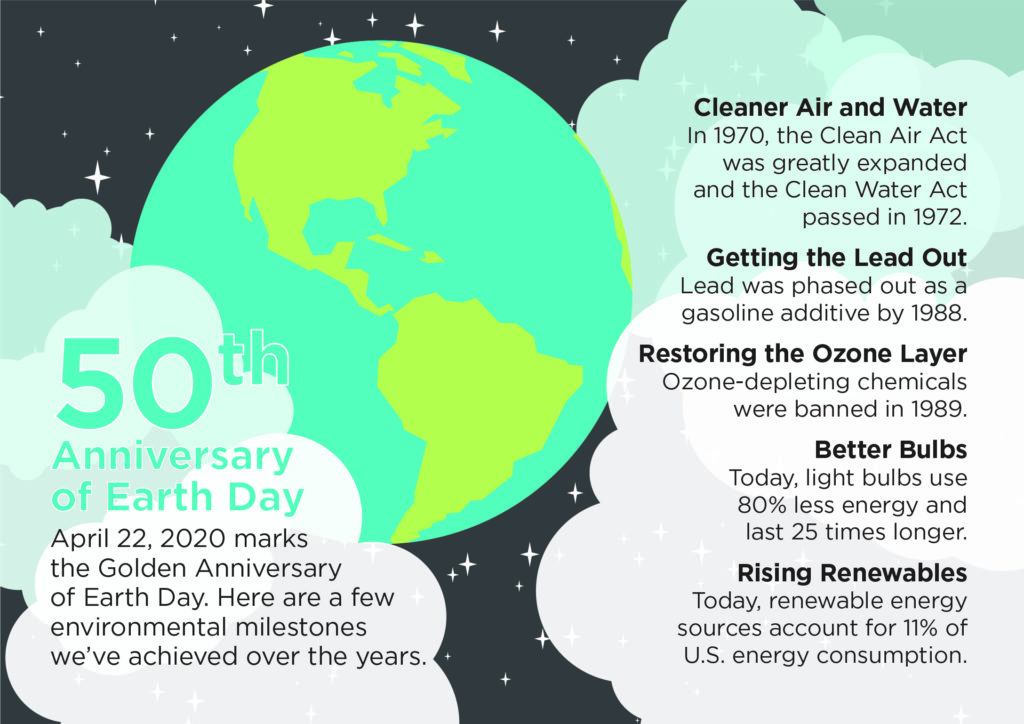
The estimated 20 million people who rallied for the first Earth Day 50 years ago might not have changed the world as much as they’d hoped, but they just might have changed it more than they thought possible.
Since that April 22 five decades ago, pollution has fallen dramatically, while energy efficiency has greatly increased. Solar energy and wind power are making serious moves toward providing a significant share of our nation’s electricity. Every major car company is expanding their electric vehicle options, and according to The Recycling Partnership, a non-profit industry group, about half the homes in the United States have some version of curbside recycling program.
At the time, even I got caught up in an Earth Day episode that illustrates another way the nation has changed its approach to the environment.
I was a senior on the high school debate team, and the topic proposed by the National Forensics League was whether the federal government should establish programs to control air and water pollution. About half of us would contend that yes, the federal government should have pollution control programs, while the other half said no. We spent our evenings filling file boxes with index cards of research to prove our side to the small panel of judges that would gather in classrooms on Saturdays for the debate tournaments.
The book that inspired Earth Day
Then, the president of the United States almost literally turned our world upside down. On July 9, 1970, less than three months after that first Earth Day, President Richard Nixon sent a reorganization plan to Congress creating the Environmental Protection Agency (EPA).
“…as a matter of effective and orderly administration, additional new independent agencies normally should not be created,” said Nixon’s formal proposal. But in this case, it continued, the EPA was needed “…because arresting environmental deterioration is of great importance to the quality of life in our country and the world.”
For some of the high school debaters, that meant suddenly switching sides the teams defending the “status quo” of no government program on the environment now had to defend a status quo that included the EPA.
While the high school debaters scrambled to rewrite their speeches, policymakers moved boldly to create sweeping federal laws: expansion of the Clean Air Act in 1970 and enactment of the Clean Water Act in 1972.
Credit for setting the stage that made Earth Day possible often goes to Rachel Carson’s 1962 book Silent Spring, about the effects of chemicals in the environment, especially linking the pesticide DDT with a decline in the number of bald eagles.
But two events in 1969 led more directly to that first Earth Day. In January, a three-million gallon oil spill coated beaches along Southern California, and in June, pollution in Cleveland’s Cuyahoga River caught fire. Organizers used the publicity from those disasters and combined them with the 1960s tactics of college student protests for civil rights and against the Vietnam War. The time of year for Earth Day was chosen for falling after spring break and before final exams. By 1972, the federal government banned DDT.
A wacky idea for reducing acid rain
The heightened awareness brought attention to other environmental issues: the lead additive in gasoline was shown to damage health in many ways; refrigerants and solvents were among chemicals blamed for depleting the ozone layer of the atmosphere, which protects the Earth from the harshest rays from the sun; and sulfur dioxide from coal-fired power plants was blamed for “acid rain” that was damaging forests.
A ban on ozone-depleting chemicals took effect in 1989, reversing damage to the ozone layer. Getting the lead out of gasoline and curbing acid rain got help through the 1980s with the innovative idea of pollution credits. The notion behind the credits, also known as emissions trading, had the government setting an overall industry limit on pollution rather than requiring reductions by each power plant or refinery. That way, a power plant could emit more than the limit if it could buy or trade emissions credits with another plant that was way under the allowed limit.
That might sound a little crazy, but it worked. Lead was phased out of gasoline from 1971 to 1988, and sulfur dioxide emissions have been reduced by 87% according to the EPA.
Huge gains in energy efficiency have also eased environmental impacts since 1970. LED light bulbs use as much as 80% less electricity and last as much as 25 times longer, says the U.S. Department of Energy. Cars and trucks are becoming more efficient and less polluting as well. The EPA reports that over the past 50 years, fuel economy has doubled and carbon dioxide emissions from vehicles have been cut in half.
The rise of renewable energy is another story of the past five decades. In 1970, nearly half of our electricity came from coal-fired power plants. Today, solar energy and wind power are on the rise, generating nearly 10% of electricity. Of all the electric generation being planned for 2020, more than three-fourths will come from wind or solar, according to the Energy Information Administration.
For all those achievements, environmental changes since the first Earth Day might be the perfect example of how a glass can be viewed as half-empty or half-full. Regardless, focusing on ways we can improve our environment will certainly take center stage on April 22, 2020, when we celebrate the 50th anniversary of Earth Day.




